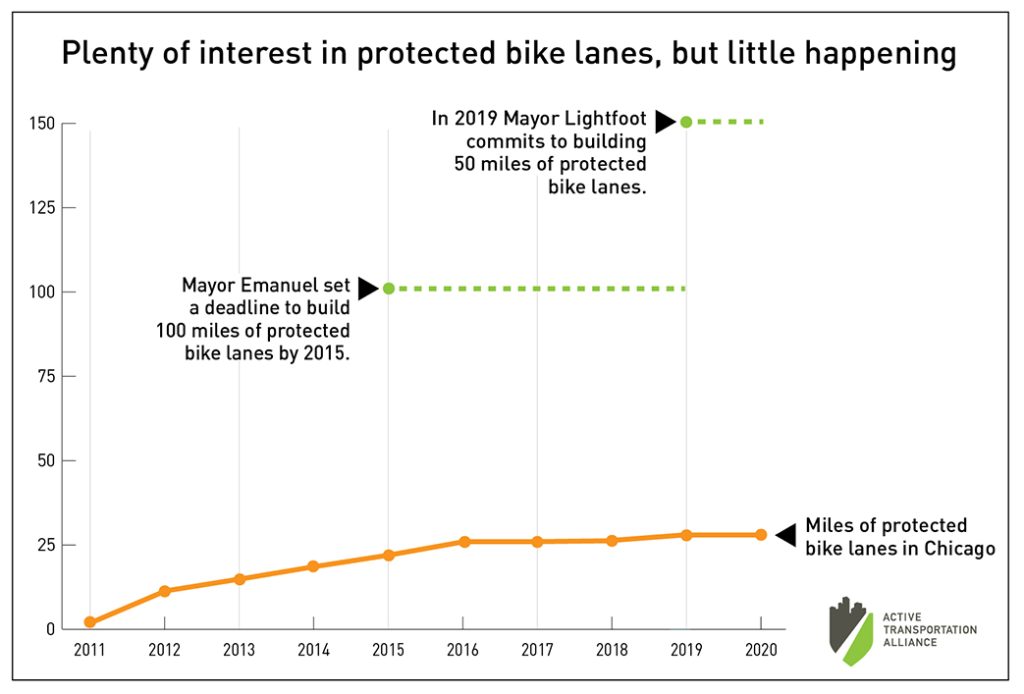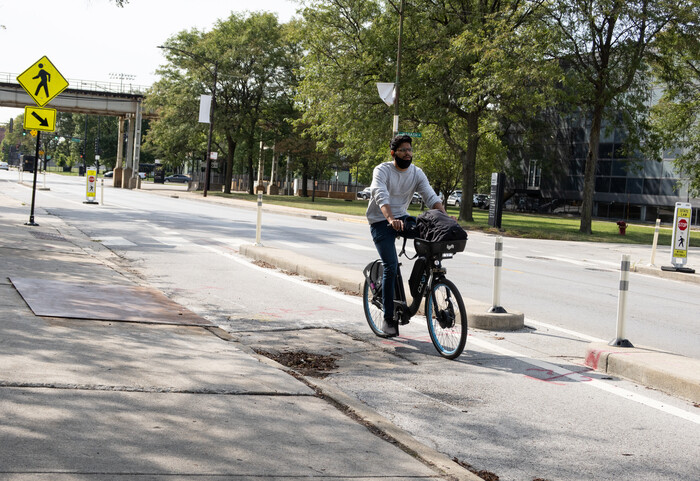We’re pleased to see that Chicago’s new Climate Action Plan features ambitious goals to reduce driving and get more people walking and biking by redesigning the city’s most dangerous streets.
Now we need to make sure city officials follow through with this plan by investing available federal, state, and local transportation funds into building a protected and connected bike network throughout the city.
People who bike deserve to be protected from dangerous car traffic no matter where they begin or end their trip.
PROTECTED BIKE LANES AND CLIMATE
One of the 2022 Chicago Climate Action Plan’s five major goals is to deliver a robust zero-emission transportation network that connects communities and improves air quality. One of the strategies to accomplish this goal is to make walking, biking, or transit viable options for all trips.
The plan features a commitment to “add 25 more miles of protected bike lanes, 25 more miles of neighborhood greenways, and eliminate 15 miles of gaps in the citywide bikeways network by the end of 2024.”
Given that earlier versions of the plan lacked any specific infrastructure goals, we were pleased to see actual mileage goals included in the final plan.
Thank you to the hundreds of residents who called on the city to add a protected bike lane goal. City data shows bike lanes were one of the most talked about issues among the 2,145 residents who shared input during the plan’s public comment period.
People feel most comfortable when biking on a road that has physical protection from cars and trucks. Protected bike lanes have been proven to increase safety and comfort when biking. So it shouldn’t be a surprise that when people have access to protected bike lanes, they get excited about biking and tend to ride more.
PROTECTED AND CONNECTED NETWORK
While the climate action plan goal is encouraging, questions remain. Where will the new PBLs be built? Will they be built in ways that keep them from getting blocked by cars and trucks?
To maximize the impact of new protected bike lanes, city officials must fill key gaps in the existing network and use concrete barriers in building them.
From 2016 to 2020, total mileage of protected bike lanes remained stagnant despite commitments made by Mayors Emanuel and Lightfoot to increase the number of protected bike lanes.

Today, Chicago has only 35 miles of protected bike lanes, and the new climate plan suggests city officials aim to continue the recent positive trend of building about 12 new miles every year.
While we’d love to see a more ambitious approach, building 12 miles of protected bike lanes per year can go a long way toward speeding up progress in creating a network of protected bike lanes and connecting destinations.
QUANTITY AND QUALITY
The existing protected bike lanes vary in quality — with paint and plastic bollards, unfortunately, being the default.
Currently, the approach to installing a protected bike lane is on a spot-by-spot basis. This approach of installing protected bike lanes has built small stretches that may connect to a standard bike lane or, in some cases, to no bike lane at all. Instead, the focus should be to provide protection on entire corridors or large stretches of a corridor.

Here are some additional points to consider as these lanes are getting planned and built:
- The need is greatest in South and West Side communities where streets have too many lanes and lack critical bike safety infrastructure.
- Without physical protection, drivers will continue to drive and park on bike lanes and increase dangerous situations, requiring people to navigate around parked cars and merge into traffic.
- Investing in a network of protected bike lanes can incentivize people to bike to destinations that would have been a short drive. So let’s make sure protected bike lanes connect people to their daily destinations.
- Shared electric scooters users will also benefit from a network of protected bike lanes.
- Existing protected bike lanes can also be improved to increase safety and provide a fully protected bike lane.
Building protected bike lanes on these routes requires the cooperation and coordination of multiple agencies that control road jurisdictions across the city: CDOT, Cook County Department of Transportation and Highways, and the Illinois Department of Transportation. Also, cooperation is needed from alderpeople to build long stretches of protected bike lanes across wards.
Chicago needs to fundamentally re-imagine key corridors and make them truly safe for walking, biking, or riding a scooter. We need to stop the spot-by-spot approach and build a protected and connected bike network now.


